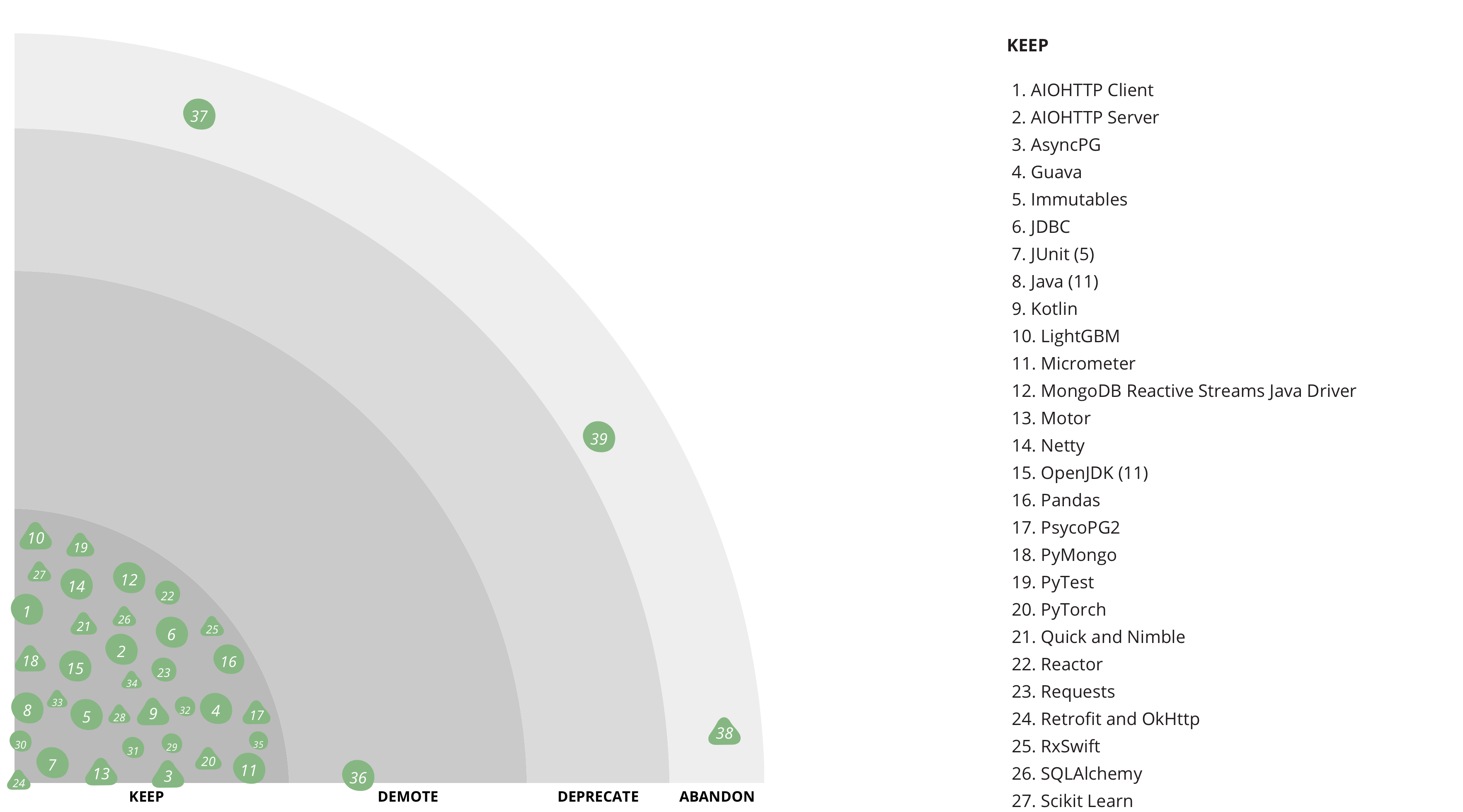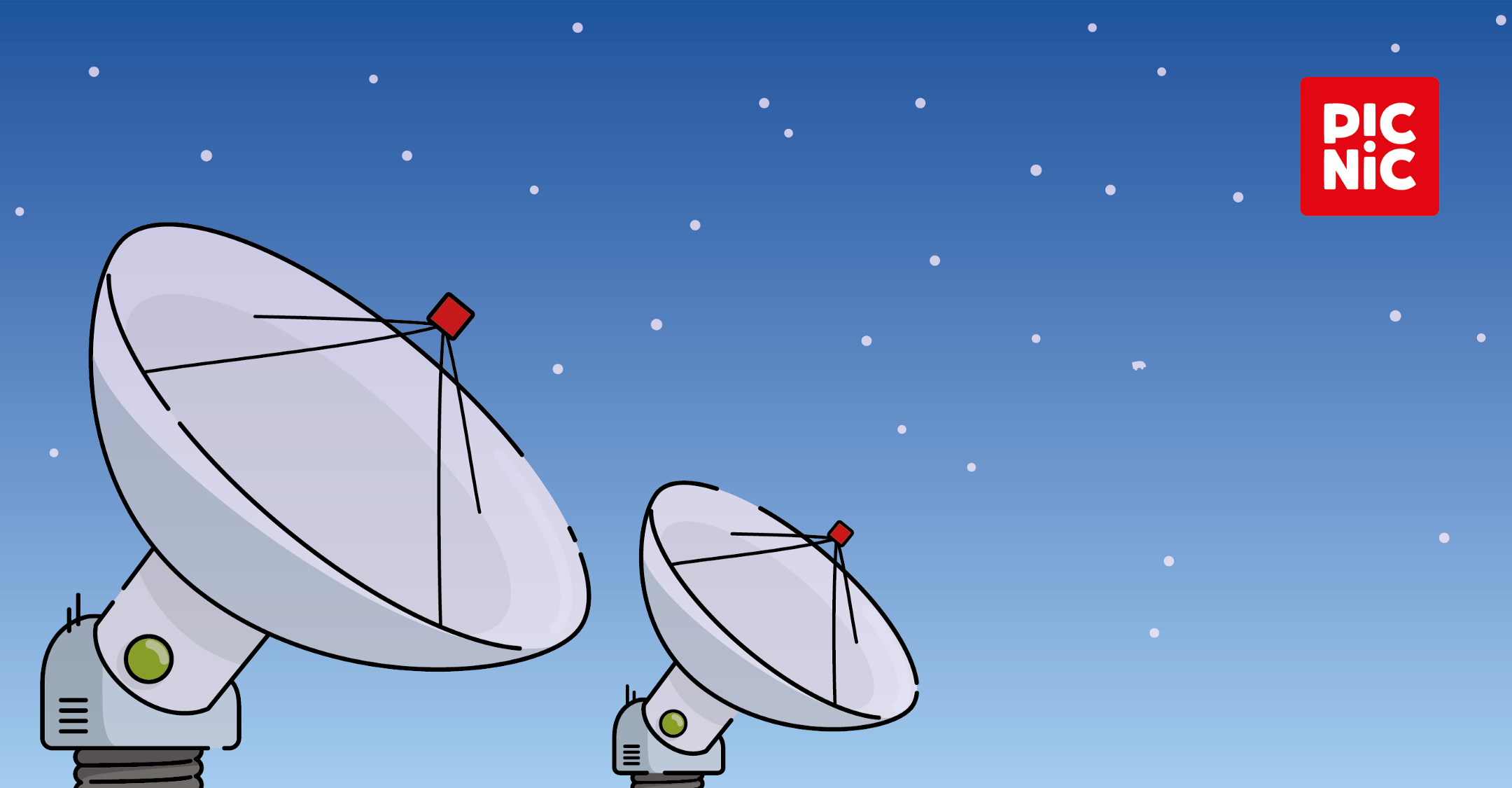Opinionated tech radars have been on the rise as of late. The Lindy effect postulates that the future life expectancy of non-perishable things like a technology are proportional to their current age. That is, as we move forward in time, we acquire more technology than we replace. This applies to humanity as a whole, but also at an organisation level. Tech radars are being utilised as a means of tracking existing usages, and future developments of technologies within organisations. At Picnic we strive to stay on top of technical debt. We value keeping our tech stack consolidated and lightweight, and we prioritise moving away from deprecated dependencies. This requires not only having a good view on what we use, but also what technologies exist out there. In a tech company that has seen rapid growth both before and during the pandemic, clear alignment around our tech stack is becoming a necessity.
For these reasons, we needed a radar to help guide us. Inspired by ThoughtWorks, Zalando, and more recently the CNCF, we have devised our own take on the concept. Two tech radars,one for new tech and another for current tech,that seek to answer three key questions to help consolidate our tech strategy:
- What did our tech stack look like, and what did we learn from it?
- What does our tech stack look like, and what are our opinions about it?
- Whatwill our tech stack look like, and what are our ambitions for it?
The Tech Radars
The Radars can be found here:
Credit to ThoughtWorks for the great tool. If you aren’t tempted by a link alone, check out one of our thriving quadrants of current Picnic technologies below. As is evident, we like to keep the place clean.

In order to make a clear distinction between new technologies and existing technologies, we have split the radar into two. One radar for each process. The quadrants of the radar are equivalent, but the rings of both radars better reflect the state of a technology within the company. Whilst it is tricky to really pin down the term technology, we adhere to the established ThoughtWorks taxonomy of Platforms, Languages & Frameworks, Techniques and Tools. In order to facilitate the process, we have started a Tech Horizons guild. The guild mediates the discussion and process with the submission and reviewal of ring change proposals, RFC-style documents that propose a technology state change from one ring to another including reasonings, plans and evaluation criteria. In the case of adoption, this is acceptance criteria, and in the case of abandonment, migration plans.
The Rings of Change
Rings represent the status of a technology within the organisation. For Picnic’s current tech stack radar we have four mutually exclusive rings:
Keep: the technology is mature and relevant for use in Picnic, and we can distinguish clearly between use and don’t use cases.
Demote: the technology is outdated, and alternative approaches should be pursued if and where possible. Teams are recommended to migrate.
Deprecate: the technology is no longer permitted for new usages and is therefore banned with a clear path for a migration to an alternative.
Abandon: all usages of a technology are to be removed imminently. Migration plans to an alternative are laid out.
For Picnic’s new tech radar we have four mutually exclusive rings:
Registered: the entry point. A party identifies a technology that is of relevance to Picnic and registers it on the radar.
Assess: the technology is in assessment by the guild and others if there appears to be a clear use case for it.
Trial: the technology is in trial, i.e. a PoC is built. The guild identifies an opportunity for the technology to be applied and aligns on the terms, acceptance criteria and objective of a trial with an adopting tech team.
Adopt: the technology meets all acceptance criteria and is offered for adoption in the wider tech team with clear use and don’t use cases and a clear plan for expansion of support and ownership.
The Guild’s Mission Statement
The aim of the guild is then to mediate the technology adoption and removal process with a four pronged approach:
- Keep the Picnic tech stack free of outdated, legacy, and unmaintained technologies.
- Provide a forum and process for the prudent adoption of new technologies.
- Centralise discussions and opinions of current and future tech, to galvanise the Picnic tech vision.
- Utilise the knowledge and research of all team members and external parties to contribute to, validate and review our tech radars, to make sure we don’t miss a beat!
What’s to come?
Every quarter the guild will produce updated Picnic Tech Radars and share them with the world. We hope that this will give you an insight into what we do here at Picnic, our vision for the future, and also kick-off an engagement with relevant tech communities. In the coming blogs we will dive deeper by selecting a sector of particular interest. Let us know below what topics you would like us to dive into next!
Thanks to Stephan Schroevers, Gijs van der Voort, Ernir Þorsteinsson, Iliana Iankoulova, Sjoerd Cranen, Dimitar Nedev, Lars Lockefeer and all those in the Picnic tech team who contributed to, and drove the creation of the first Picnic Tech Radars!


 Erdem Erbas
Erdem Erbas







